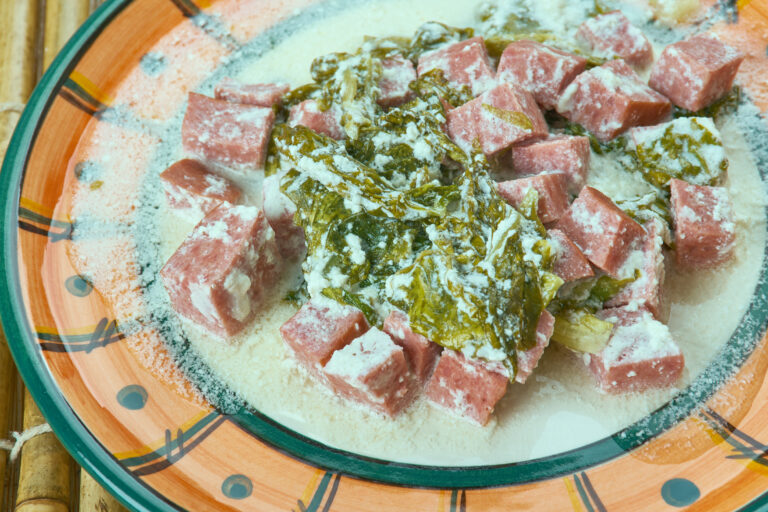Palusami is a traditional Samoan dish, deeply rooted in the island’s culture and history. It’s a simple yet flavorful meal, often enjoyed during family gatherings and special occasions.
Our team at Remitly created this guide as part of our series that celebrates the traditional foods of our global customers.
The Origin of Palusami
The origins of Palusami are as rich as the dish itself. It’s believed to have been created by early Polynesian settlers who brought with them taro plants from Southeast Asia. These hardy plants thrived in Samoa’s tropical climate, becoming a staple food source for the islanders.
Over time, the Samoans developed various ways to prepare taro leaves, one of which was wrapping them around a filling made from coconut cream and onions. This method resulted in what we now know as Palusami—a beloved dish that has stood the test of time.
Ingredients Used in Palusami
The beauty of Palusami lies in its simplicity. The main ingredients are young taro leaves and coconut cream—both readily available resources on the islands. Onions add depth to the flavor profile while salt provides balance.
Some variations may include canned corned beef or fresh fish for added protein. However, at its core, Palosumi remains a plant-based dish that showcases Samoa’s abundant natural produce.
Making Palusami is an exercise in patience and precision. First, young taro leaves are carefully cleaned and layered into small bundles. A mixture of coconut cream and finely chopped onions is then spooned onto each bundle before they’re wrapped tightly.
These parcels are placed into an umu—a traditional Samoan earth oven—and left to cook slowly over hot stones for several hours. The result? A creamy, savory delight that melts in your mouth.
A Simple Palusami Recipe
Palusami is a dish that’s easy to prepare, yet rich in flavor. Here’s a basic recipe you can try at home.
Ingredients:
- 20 young taro leaves
- 2 cans of coconut cream (approximately 800ml)
- 1 large onion, finely chopped
- Salt to taste
Instructions:
- Start by cleaning the taro leaves thoroughly. Make sure to remove any dirt or insects.
- Layer five taro leaves on top of each other, ensuring the stems all face the same direction.
- Spoon some coconut cream onto the center of the layered leaves, followed by a sprinkle of chopped onions and salt.
- Fold the leaves over the filling, creating a small parcel. Repeat this process until all ingredients are used up.
- Place these parcels into an oven-safe dish and cover with aluminum foil.
- Bake in a preheated oven at 180°C (350°F) for about two hours or until the parcels become soft and creamy.
- Allow them to cool slightly before serving.
Remember, this is just one way to make Palusami—feel free to experiment with different fillings based on your preference.
Variations of the Dish Across Samoa
While the basic recipe remains consistent across Samoa, regional variations do exist. Some families prefer adding meat or fish to their palusami, while others stick to the traditional vegetarian version. There are also variations of this dish through the region and countries like Kiribati, and Tuvalu have their own version of this dish.
In some parts of Samoa, ripe bananas or breadfruit are added for a hint of sweetness. Regardless of the variation, all versions share the same comforting creaminess that has made Palusami a favorite among Samoans.
Serving and Eating Etiquette
Palusami is typically served in its leafy parcel, adding an element of surprise to each meal. It’s often eaten with hands—a common practice in Samoan culture—and accompanied by taro root or rice.
While there’s no strict etiquette around eating Palusami, it’s generally considered polite to wait until everyone is served before unwrapping your parcel. After all, sharing food is a significant part of Samoan hospitality.
The Broader Cuisine of Samoa
Samoan cuisine is as diverse as it is flavorful, reflecting the islands’ rich cultural heritage and abundant natural resources.
Staple Foods
Taro root and breadfruit are staple foods in Samoa—often boiled or baked and served alongside main dishes like Palusami or Luau (another popular taro leaf dish). Seafood also plays a significant role in Samoan cuisine due to its accessibility.
Traditional Cooking Methods
The umu—a traditional earth oven—is frequently used for cooking meals in Samoa. Food cooked in an umu takes on a distinct smoky flavor that’s highly appreciated among locals.
Popular Dishes
Beyond Palusami, other popular dishes include Faiai Eleni (fish cooked in coconut cream), Sapasui (Samoan chop suey), and Povi Masima (salted beef). Each dish showcases the islands’ fresh produce and love for hearty, comforting meals.
Sweet Treats
Samoans have a sweet tooth too. Panipopo (sweet coconut buns) and Keke Pua’a (pork buns) are well-loved treats often enjoyed during teatime or as dessert.
The Influence of Migration
Migration has also influenced Samoan cuisine. Many Samoans living abroad have incorporated elements from their host countries into traditional recipes—creating a fusion of flavors that’s uniquely Samoan yet globally appealing.
Visit the homepage, download our app, or check out our Help Center to get started.
